A New Strategy for Consumption of Functional Lipids from Ericerus pela (Chavannes): Study on Microcapsules and Effervescent Tablets Containing Insect Wax–Derived Policosanol
Abstract
:1. Introduction
2. Materials and Methods
2.1. Chemicals and Reagents
2.2. Preparation of Microencapsules Containing Insect Wax–Derived Policosanol
2.2.1. Wall Material Ratio and Core-to-Wall Material Ratio
2.2.2. Solid Content and Feed Temperature
2.2.3. Inlet Air Temperature and Hot-Air Flow Rate
2.3. Determination of Indicators of Microcapsules Containing Insect Wax–Derived Policosanol
2.3.1. Microencapsulation Efficiency and Powder Yield
2.3.2. Water Content and Water Dispersion
2.3.3. Bulk Density and Surface Morphology
2.3.4. Residence Time of Microcapsules in Simulated Stomach Fluid
2.4. Preparation of Effervescent Tablets Containing Insect Wax–Derived Policosanol
2.5. Determination of Quality Indicators of Effervescent Tablets Containing Insect Wax–Derived Policosanol
2.5.1. pH
2.5.2. Friability and Hardness
2.5.3. Disintegration Time
2.5.4. Bubble Volume
3. Results and Discussion
3.1. Optimization of Conditions for Preparation of Microcapsules Containing Insect Wax–Derived Policosanol
3.1.1. Effects of Wall Material Ratio and Core-to-Wall Material Ratio on Microencapsulation
3.1.2. Effects of Solid Content and Feed Temperature on Microencapsulation
3.1.3. Effects of Inlet Air Temperature and Hot-Air Flow Rate on Microencapsulation
3.2. Quality Indicators of Microcapsules Containing Insect Wax–Derived Policosanol
3.3. Effervescent Tablets Containing Insect Wax–Derived Policosanol
4. Conclusions
Author Contributions
Funding
Data Availability Statement
Conflicts of Interest
References
- Van Huis, A. Insects as food and feed, a new emerging agricultural sector: A review. J. Insects Food Feed 2020, 6, 27–44. [Google Scholar] [CrossRef]
- Feng, Y.; Chen, X.; Zhao, M. Edible Insects of China; Science Press: Beijing, China, 2016. [Google Scholar]
- Meyer-Rochow, V.B.; Gahukar, R.T.; Ghosh, S.; Jung, C. Chemical composition, nutrient quality and acceptability of edible insects are affected by species, developmental stage, gender, diet, and processing method. Foods 2021, 10, 1036. [Google Scholar] [CrossRef] [PubMed]
- Baek, S.; Mae, A.S.; Nam, I. Optimization of the heat-drying conditions of drone pupae by response surface methodology (RSM). Foods 2023, 12, 3062. [Google Scholar] [CrossRef] [PubMed]
- Yang, Q.; Liu, G.; Wei, M. Research advances in nutrition and development of insect oil. Food Sci. Technol. 2008, 33, 246–249. [Google Scholar]
- Perez-Santaescolastica, C.; De Winne, A.; Devaere, J.; Fraeye, I. The flavour of edible insects: A comprehensive review on volatile compounds and their analytical assessment. Trends Food Sci. Technol. 2022, 127, 352–367. [Google Scholar] [CrossRef]
- Lange, K.W.; Nakamura, Y. Edible insects as future food: Chances and challenges. J. Future Foods 2021, 1, 38–46. [Google Scholar] [CrossRef]
- Chinarak, K.; Panpipat, W.; Panya, A.; Phonsatta, N.; Cheong, L.-Z.; Chaijan, M. A novel strategy for the production of edible insects: Effect of dietary perilla seed supplementation on nutritional composition, growth performance, lipid metabolism and desaturase gene expression of sago palm weevil (rhynchophorus ferrugineus) larvae. Foods 2022, 11, 2036. [Google Scholar] [CrossRef]
- Yang, P.; Zhu, J.; Chen, X.; Li, M. Isolation and characterization of microsatellite loci from the Chinese white wax scale Ericerus pela Chavannes (Homopetera: Coccidae). Afr. J. Microbiol. Res. 2011, 5, 1246–1248. [Google Scholar]
- Yang, P.; Zhu, J.; Meng, L.; Li, J.; Chen, X. Soluble proteome analysis of male Ericerus pela Chavannes cuticle at the stage of the second instar larva. Afr. J. Microbiol. Res. 2011, 5, 1108–1118. [Google Scholar]
- Lin, L.; Zhou, Y.; Li, H.; Pang, D.; Zhang, L.; Lu, X.; Chen, Z.; Zhao, X.; Zuo, D.; Sun, L. Polysaccharide extracted from Chinese white wax scale ameliorates 2,4-dinitrochlorobenzene-induced atopic dermatitis-like symptoms in BALB/c mice. Saudi Pharm. J. 2017, 25, 625–632. [Google Scholar] [CrossRef]
- Hu, Y.-H.; Chen, X.-M.; Yang, P.; Ding, W.-F. Characterization and functional assay of a fatty acyl-CoA reductase gene in the scale insect, Ericerus pela Chavannes (Hemiptera: Coccoidae). Arch. Insect Biochem. Physiol. 2018, 97, e21445. [Google Scholar] [CrossRef] [PubMed]
- Feng, Y.; Chen, X.; Ma, Y.; He, Z. Experimental study on immunomodulation of white wax scale (Ericerus pela Chavannes). For. Res. 2006, 19, 221–224. [Google Scholar]
- Feng, Y.; He, Z.; Li, X.; Chen, Z.; Sun, L. Immunomodulatory and Antitumor Activities of Polysaccharide from Chinese White Wax Scale. For. Res. 2014, 27, 388–392. [Google Scholar]
- Chen, X. Natural Population Ecology of Ericerus pela; Science Press: Beijing, China, 2011. [Google Scholar]
- Ma, J.; Li, K.; Zhang, W.; Ma, L.; Xu, J.; Liu, L.; Chen, X.; Zhang, H. Acute toxicity and chromosomal aberration toxicity of insect wax and its policosanol. Food Sci. Hum. Wellness 2022, 11, 356–365. [Google Scholar] [CrossRef]
- Ma, J.; Ma, L.; Zhang, H.; Zhang, Z.; Wang, Y.; Li, K.; Chen, X. Policosanol fabrication from insect wax and optimization by response surface methodology. PLoS ONE 2018, 13, e0197343. [Google Scholar] [CrossRef] [PubMed]
- Ma, J.; Ma, L.; Zhang, H.; Zhang, Z.; Wang, Y. The preparation and evaluation of efficacy on skin wound healing in mice of insect wax compound ointment. J. Environ. Entomol. 2018, 40, 1238–1247. [Google Scholar]
- Ma, J.; Ma, L.; Li, K.; Zhang, W.; Zhang, Y.; Yang, M.; Chen, X.; Zhang, H. Preparation of microemulsion with policosanol derived from insect wax and its application in functional beverage. Food Sci. 2019, 40, 78–84. [Google Scholar]
- Wang, Z.; Feng, Y.; Ma, L.; Li, X.; Ding, W.; Chen, X. Hair growth promoting effect of white wax and policosanol from white wax on the mouse model of testosterone-induced hair loss. Biomed. Pharmacother. 2017, 89, 438–446. [Google Scholar] [CrossRef]
- Ma, L.; Wang, Y.; Zhang, Z.; Zheng, H.; Gan, J.; Li, Z.; Duan, Q. Preparation of policosanol from insect wax. Sci. Technol. Food Ind. 2008, 29, 179–181. [Google Scholar]
- Ma, L.; Wang, Y.; Zhang, Z.; Gan, J.; Zheng, H.; Guo, Y.; Zhao, H.; Qiongfen, D. Preparation of policosanol from insect wax by reduction method. Chem. Ind. For. Prod. 2009, 29, 6–10. [Google Scholar]
- Venturelli, A.; Brighenti, V.; Mascolo, D.; Pellati, F. A new strategy based on microwave-assisted technology for the extraction and purification of beeswax policosanols for pharmaceutical purposes and beyond. J. Pharm. Biomed. Anal. 2019, 172, 200–205. [Google Scholar] [CrossRef] [PubMed]
- Shen, J.; Luo, F.; Lin, Q. Policosanol: Extraction and biological functions. J. Funct. Foods 2019, 57, 351–360. [Google Scholar] [CrossRef]
- Lee, E.-Y.; Yoo, J.-A.; Lim, S.-M.; Cho, K.-H. Anti-Aging and Tissue Regeneration Ability of Policosanol Along with Lipid-Lowering Effect in Hyperlipidemic Zebrafish via Enhancement of High-Density Lipoprotein Functionality. Rejuvenation Res. 2016, 19, 149–158. [Google Scholar] [CrossRef] [PubMed]
- Zhang, W.; Zheng, H.; Feng, Y.; Xu, J.; Hou, B.; Liu, L.; Zhang, H. Microencapsulation of Phyllanthus emblica L. Fruit Juice. Food Sci. 2015, 36, 25–29. [Google Scholar]
- Sánchez, C.A.O.; Zavaleta, E.B.; García, G.R.U.; Solano, G.L.; Díaz, M.P.R. Krill oil microencapsulation: Antioxidant activity, astaxanthin retention, encapsulation efficiency, fatty acids profile, in vitro bioaccessibility and storage stability. LWT-Food Sci. Technol. 2021, 147, 111476. [Google Scholar] [CrossRef]
- Li, Y. Study of Extraction of Octacosanol from Rice Bran and Its Microencapsulation. Master’s Thesis, Hebei Agricultural University, Baoding, China, 2013. [Google Scholar]
- Luo, C.; Cheng, Y.; Yi, Y.; Xia, B.; Zhou, H.; Cao, X. Optimization of preparation process for blend microcapsules of phytosterol esters and puerarin. Food Sci. 2016, 37, 26–33. [Google Scholar]
- Rodríguez-Cortina, A.; Rodríguez-Cortina, J.; Hernández-Carrión, M. Obtention of Sacha Inchi (Plukenetia volubilis Linneo) Seed Oil Microcapsules as a Strategy for the Valorization of Amazonian Fruits: Physicochemical, Morphological, and Controlled Release Characterization. Foods 2022, 11, 3950. [Google Scholar] [CrossRef]
- Chen, F. Study on the Extraction, Purification and the Anti-Fatigue Function of Octacosanol from Rice Bran. Ph.D. Thesis, China Agricultural University, Beijing, China, 2003. [Google Scholar]
- Committee, N.P. Chinese Pharmacopoeia (Part IV); China Medical Science and Technology Press: Beijing, China, 2015. [Google Scholar]
- Zhang, Y.; Gong, C. Study on sodium octenylsuccinate starch with low viscosity used as wall materials to microencapsulate oil. Food Sci. 2006, 27, 148–152. [Google Scholar]
- He, H.; Hong, Y.; Gu, Z.; Liu, G.; Cheng, L.; Li, Z. Improved stability and controlled release of CLA with spray-dried microcapsules of OSA-modified starch and xanthan gum. Carbohydr. Polym. 2016, 147, 243–250. [Google Scholar] [CrossRef]
- Sweedman, M.C.; Tizzotti, M.J.; Schäfer, C.; Gilbert, R.G. Structure and physicochemical properties of octenyl succinic anhydride modified starches: A review. Carbohydr. Polym. 2013, 92, 905–920. [Google Scholar] [CrossRef]
- İlhan Dincer, E.; Temiz, H. Investigation of physicochemical, microstructure and antioxidant properties of firethorn (Pyracantha coccinea var. lalandi) microcapsules produced by spray-dried and freeze-dried methods. S. Afr. J. Bot. 2023, 155, 340–354. [Google Scholar] [CrossRef]
- Maury, M.; Murphy, K.; Kumar, S.; Shi, L.; Lee, G. Effects of process variables on the powder yield of spray-dried trehalose on a laboratory spray-dryer. Eur. J. Pharm. Biopharm. 2005, 59, 565–573. [Google Scholar] [CrossRef] [PubMed]
- Villalobos-Espinosa, J.C.; García-Armenta, E.; Alamilla-Beltrán, L.; Quintanilla-Carvajal, M.X.; Azuara-Nieto, E.; Hernández-Sánchez, H.; Perea-Flores, M.d.J.; Gutiérrez-López, G.F. Effect of pumping and atomisation on the stability of oil/water emulsions. J. Food Eng. 2022, 327, 111056. [Google Scholar] [CrossRef]
- Liu, Z.; Cao, Y.; Tan, F. Microencapsulation of evening primrose oil with starch sodium octenylsuccinate. J. Dalian Inst. Light Ind. 2007, 26, 337–341. [Google Scholar]
- Saifullah, M.; Yusof, Y.A.; Chin, N.L.; Aziz, M.G.; Mohammed, M.A.P.; Aziz, N.A. Dissolution profiling and its comparison of natural fruit powder effervescent tablets. J. Food Eng. 2016, 178, 60–70. [Google Scholar] [CrossRef]
- Barbosa-Cánovas, G.V.; Ortega-Rivas, E.; Juliano, P.; Yan, H. Food Powders: Physical Properties, Processing, and Functionality; Springer: Berlin/Heidelberg, Germany, 2005; Volume 86. [Google Scholar]
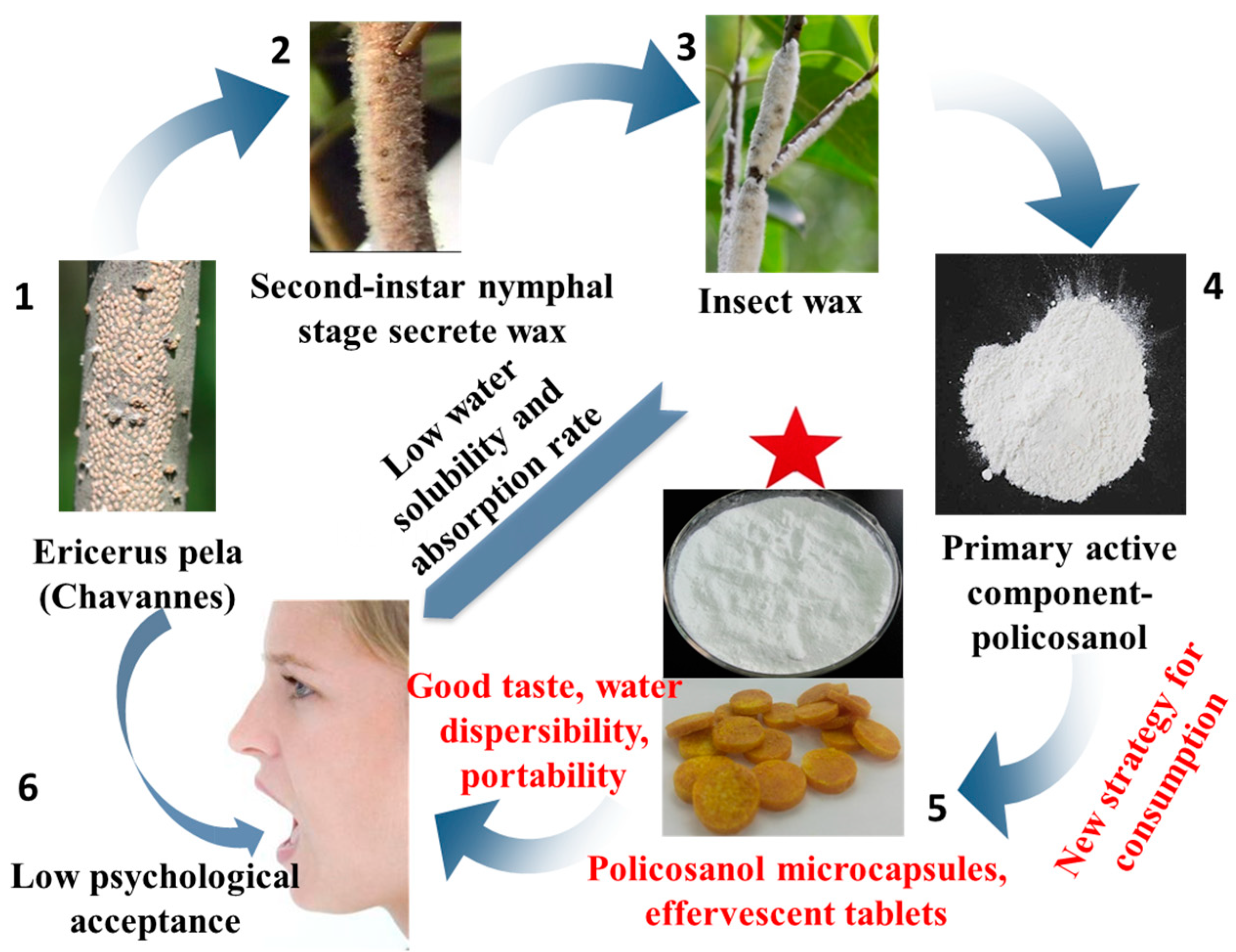
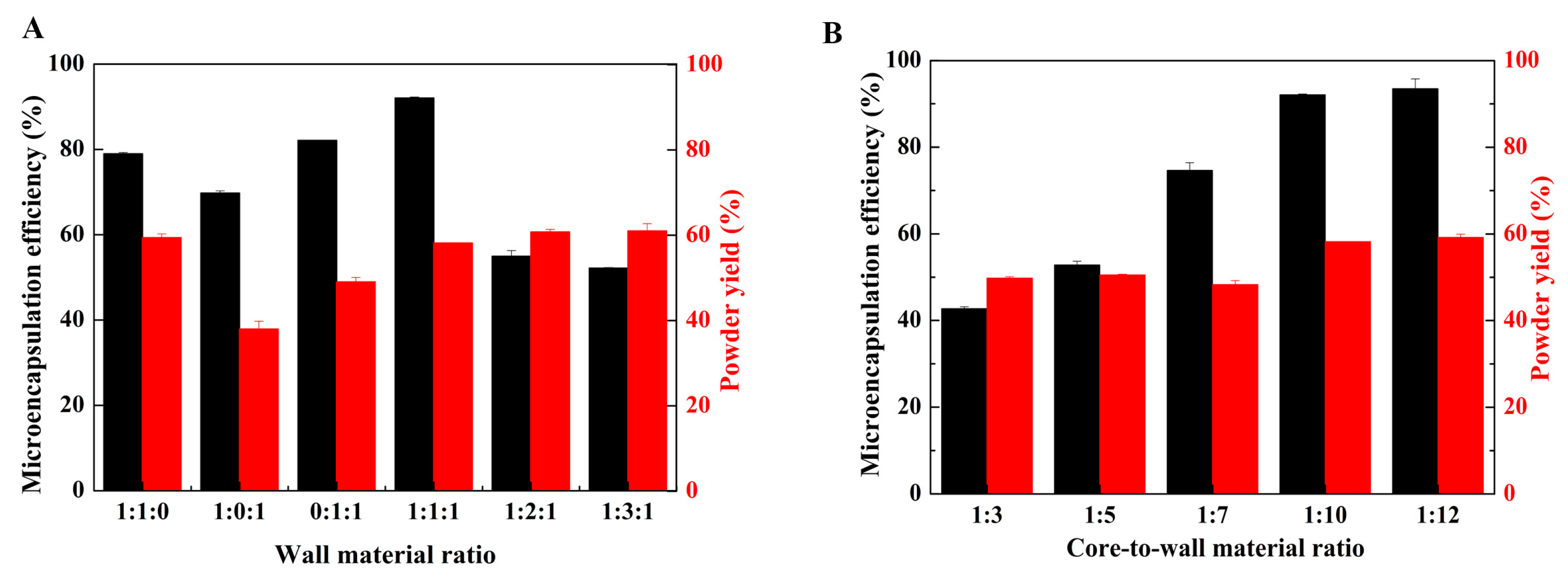
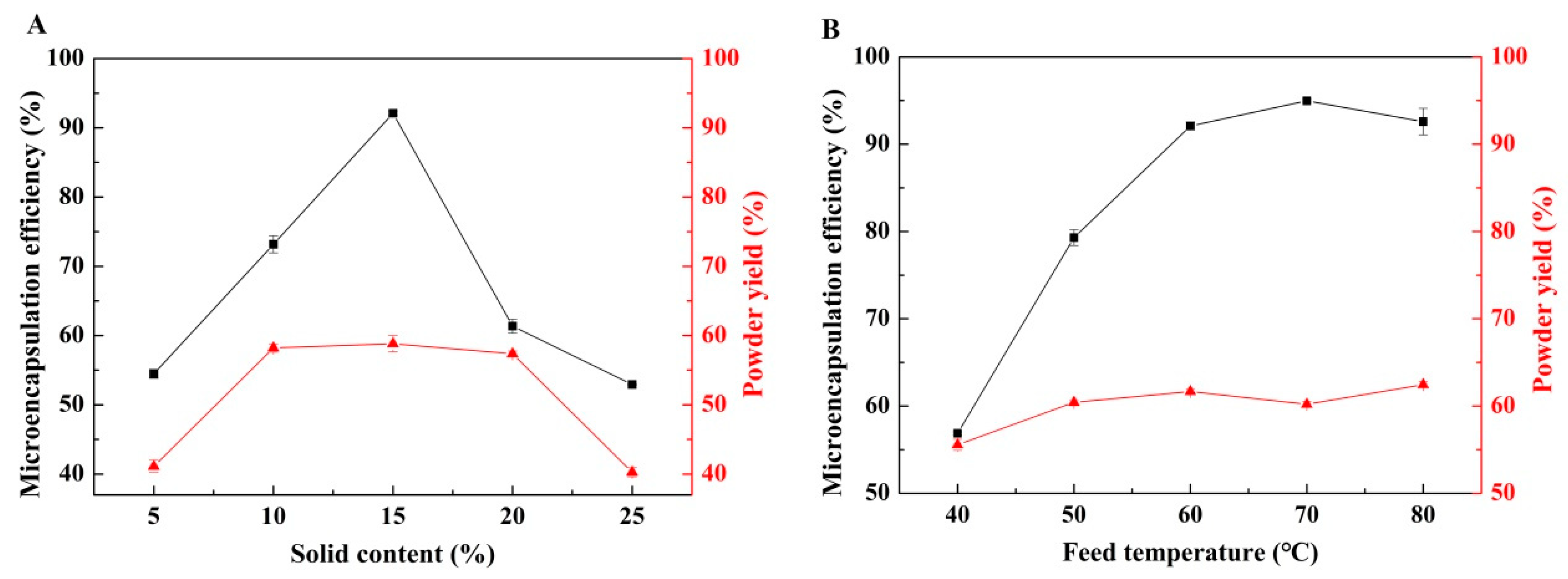
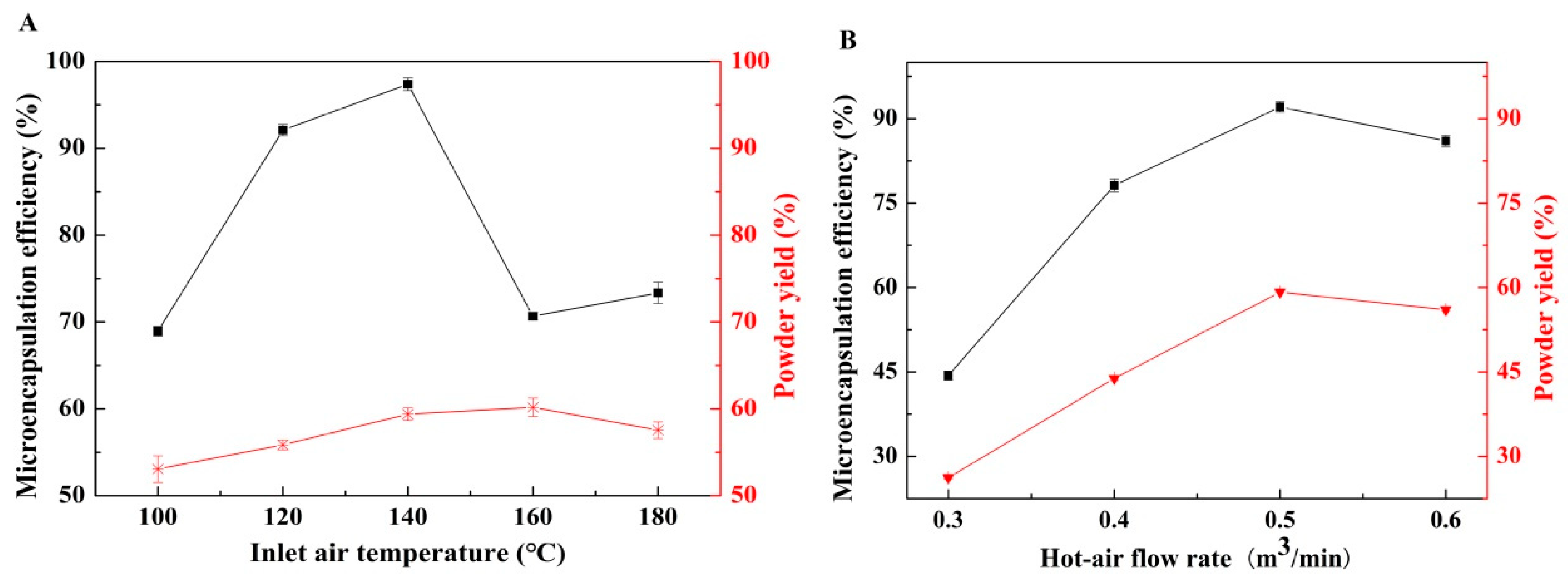

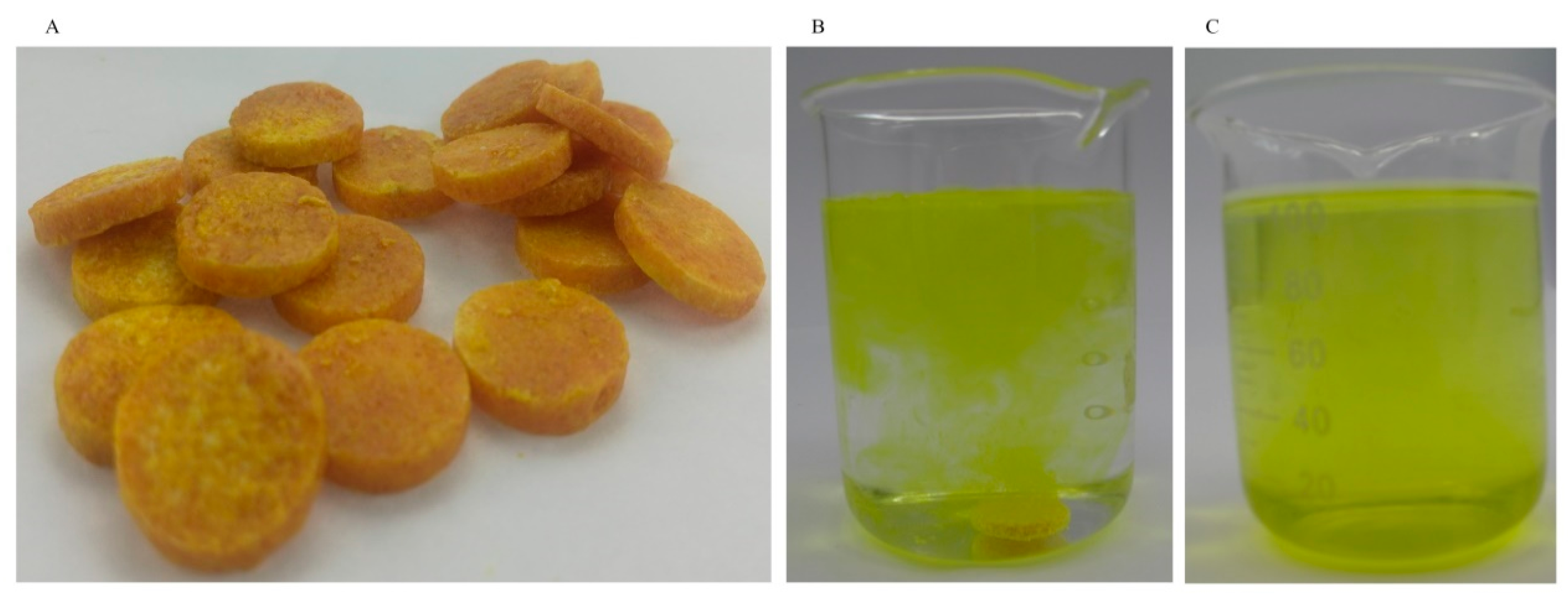
| Property | Value |
|---|---|
| Water content (%) | 1.82 ± 0.44 |
| Water dispersion time (s) | 143.5 ± 5.1 |
| Water dispersion (%) | 96.5 ± 0.9 |
| Bulk density (g/mL) | 0.26 ± 0.01 |
| Residence time in simulated stomach fluid (min) | 60.0 ± 2.6 |
| Property | Value |
|---|---|
| pH | 6.66 ± 0.14 |
| Friability (%) | 0.32 ± 0.01 |
| Hardness (N) | 30.52 ± 2.31 |
| Disintegration time (s) | 99.50 ± 9.9 |
| Bubble volume (mL) | 8.70 ± 1.5 |
Disclaimer/Publisher’s Note: The statements, opinions and data contained in all publications are solely those of the individual author(s) and contributor(s) and not of MDPI and/or the editor(s). MDPI and/or the editor(s) disclaim responsibility for any injury to people or property resulting from any ideas, methods, instructions or products referred to in the content. |
© 2023 by the authors. Licensee MDPI, Basel, Switzerland. This article is an open access article distributed under the terms and conditions of the Creative Commons Attribution (CC BY) license (https://creativecommons.org/licenses/by/4.0/).
Share and Cite
Liu, Y.; Zhang, H.; Xu, J.; He, R.; Ma, J.; Chen, C.; Liu, L. A New Strategy for Consumption of Functional Lipids from Ericerus pela (Chavannes): Study on Microcapsules and Effervescent Tablets Containing Insect Wax–Derived Policosanol. Foods 2023, 12, 3567. https://doi.org/10.3390/foods12193567
Liu Y, Zhang H, Xu J, He R, Ma J, Chen C, Liu L. A New Strategy for Consumption of Functional Lipids from Ericerus pela (Chavannes): Study on Microcapsules and Effervescent Tablets Containing Insect Wax–Derived Policosanol. Foods. 2023; 12(19):3567. https://doi.org/10.3390/foods12193567
Chicago/Turabian StyleLiu, Yiwen, Hong Zhang, Juan Xu, Rui He, Jinju Ma, Chiqing Chen, and Lanxiang Liu. 2023. "A New Strategy for Consumption of Functional Lipids from Ericerus pela (Chavannes): Study on Microcapsules and Effervescent Tablets Containing Insect Wax–Derived Policosanol" Foods 12, no. 19: 3567. https://doi.org/10.3390/foods12193567
APA StyleLiu, Y., Zhang, H., Xu, J., He, R., Ma, J., Chen, C., & Liu, L. (2023). A New Strategy for Consumption of Functional Lipids from Ericerus pela (Chavannes): Study on Microcapsules and Effervescent Tablets Containing Insect Wax–Derived Policosanol. Foods, 12(19), 3567. https://doi.org/10.3390/foods12193567






